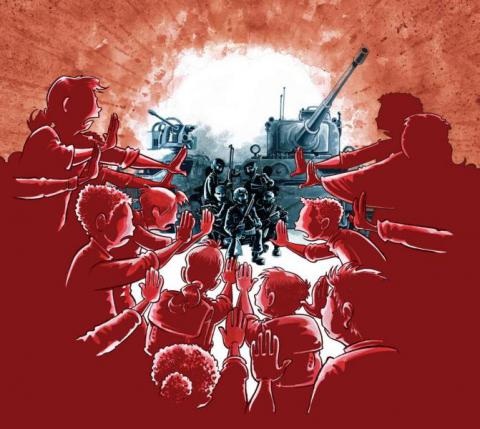At least 550,000 babies are thought to have died as a result of armed conflict between 2013 and 2017 in the 10 worst-affected countries, according to new analysis by Save the Children — an average of well over 100,000 every year — issued February 14, 2019.
The infants succumbed to indirect effects of conflict and war such as hunger, damaged infrastructure and hospitals, a lack of access to health care and sanitation, and the denial of aid. They probably would not have died if they hadn’t been living in areas affected by conflict, Save the Children says.
The total deaths from indirect effects jump to 870,000 when all children under the age of five are included. While imperfect, the estimates may be conservative, according to the charity. By comparison, Save the Children has estimated from available data that in the same five-year period almost 175,000 fighters were killed in the conflicts.
The numbers of indirect child deaths are published in a Save the Children report, Stop the War on Children, launched ahead of the February 15 opening of the Munich Security Conference. For the second year in a row, the report includes the most comprehensive collection of data on the number of children living in conflict-affected areas. It reveals that more children — almost 1 in 5 — are living in areas affected by armed conflict and war than at any time in more than 20 years.
New research by the Peace Research Institute Oslo (PRIO), commissioned by Save the Children, found that 420 million children were living in conflict-affected areas in 2017 (18 percent of all children worldwide) — up 30 million from the previous year. Afghanistan, Yemen, South Sudan, the Central African Republic, the Democratic Republic of Congo (DRC), Syria, Iraq, Mali, Nigeria, and Somalia are the countries where children were hardest hit by conflict in 2017.
Helle Thorning-Schmidt, CEO of Save the Children International, said:
“Our report shows that the way today’s wars are being fought is causing more suffering for children. Almost 1 in 5 children are living in areas impacted by conflict – more than at any time in the past two decades. The number of children being killed or maimed has more than tripled, and we are seeing an alarming increase in the use of aid as a weapon of war.
“It is shocking that in the 21st century we are going backward on principles and moral standards that are so simple – children and civilians should never be targeted.
«Our analysis clearly shows the situation is getting worse for children and the world is allowing this travesty to happen. Every day, children come under attack because armed groups and military forces disregard international laws and treaties. From the use of chemical weapons to rape as a weapon of war, war crimes are being committed with impunity.”
Part of the reason for the increased number of children living in conflict-affected areas is that today’s conflicts are more likely to be protracted, urban and fought among civilian populations. Increasingly, international rules and norms are flouted.
The Stop the War on Children report includes a breakdown of UN data on verified grave violations against children. According to these figures, grave violations rose worldwide from just under 10,000 in 2010 to more than 25,000 in 2017—the highest number on record. Every day children face the threat of being killed or maimed, recruited by armed groups, abducted, falling victim to sexual violence, seeing their school attacked or humanitarian aid denied. In many cases, children are specifically targeted.
Masika*, 15, from the DRC, is the youngest of seven children whose father died and left them unable to support themselves. She left school and joined an armed group to survive. “Everything I had thought I could do and could be one day now seemed impossible. I thought my only option was to get involved with armed groups. [The soldiers] wouldn’t stop asking me to satisfy their sexual urges and I found myself having to give in.”
Save the Children’s report also highlights how efforts to keep schools safe, avoid the use of certain weapons, seek accountability for crimes against children or pursue new ways to support their recovery from the horrors of conflict can make a huge difference in their lives.
The charity included more than 20 recommendations for governments and other influential organizations to ensure children are protected during war and conflict. The commitments range from signing a Safe Schools Declaration and a minimum age of 18 for military recruitment to the avoidance of using explosive weapons in populated areas and tightening conditions for arms sales.
Thorning-Schmidt continued: “When the rules of war are broken, the international community must be clear that this will not be tolerated and hold perpetrators to account. And for the children whose lives are wrecked by conflict, we must do all we can to protect them from further harm and help rebuild their future.”
Save the Children is also calling for an independent body to investigate and analyse all violations of international humanitarian law and of human rights, notably children’s rights.

© Save the Children
At Least 100,00 Children Die Each Year Due to War and Conflict
More children are living in areas affected by armed conflict than at any time over the past two decades, a new report from Save the Children reveals.


